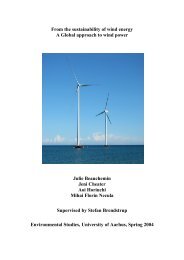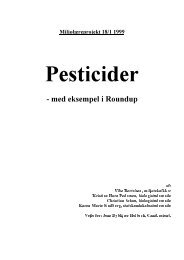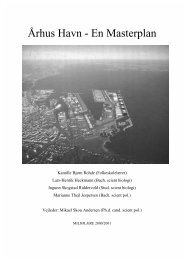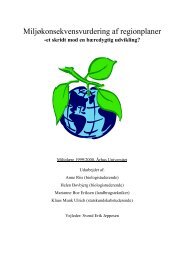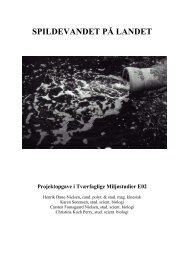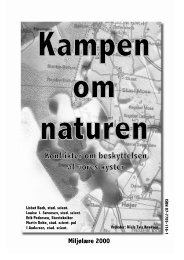University of Aarhus ECOTOURISM AS A WAY TO PROTECT ...
University of Aarhus ECOTOURISM AS A WAY TO PROTECT ...
University of Aarhus ECOTOURISM AS A WAY TO PROTECT ...
Create successful ePaper yourself
Turn your PDF publications into a flip-book with our unique Google optimized e-Paper software.
Ecotourism as a sustainable way to protect nature<br />
modalities and activities). The tourist industry should also be brought into the<br />
process <strong>of</strong> planning <strong>of</strong> the nature system in Galapagos.<br />
The conflict between the national park and the fishermen is not a story <strong>of</strong><br />
poor locals whose need for economic development is being fought by affluent<br />
outside conservationists. It is rather a struggle between new immigrants with<br />
international fishing interests. The national park, research station, tourism<br />
operators and even Galapaguaños, believe that they will get more benefits by<br />
preserving the ecosystem and promoting tourism than by exports <strong>of</strong> extracted<br />
natural resources.<br />
Concerning cultural respect (which is a part <strong>of</strong> the ecotourism protocol),<br />
the local communities <strong>of</strong> the Galapagos are virtually imported. The population<br />
consists mainly <strong>of</strong> sailors, prisoners, adventures and settlers, so this is not a<br />
significant issue on the Galapagos Islands.<br />
The Galapagos Islands is not a good roll-model for local ecotourism,<br />
which intensely involves local communities as the primary service provider and<br />
beneficiaries and which attempts to provide for minimizing impacts to their<br />
cultural and social life. Ecotourism on the Galapagos is on the other hand a good<br />
roll-model for conservation and protection <strong>of</strong> biodiversity.<br />
3.2. Ecotourism and wildlife in the Kruger National Park<br />
3.2.1. Introduction<br />
a. History<br />
Kruger National Park (KNP) lies in the Northeast <strong>of</strong> South Africa (figure<br />
5 and 6) and is one <strong>of</strong> the largest and oldest protected areas in Africa. It was<br />
declared in 1926 and now has an area <strong>of</strong> 19.458 square kilometres.<br />
57





